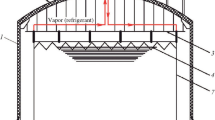Abstract
Laboratory and field experiments were carried out, to assess the efficiency of palm-based insulators for storage water tanks under variable ambient temperatures. Palm fronds, palm leaves and their composite were used to wrap pilot water tanks and examine their thermal insulation efficiency. Four arrangements were tested including: double layer of fronds and an inner air gap, double layer of fronds separated by an intermediate air gap, palm leaves and composite of palm leaves sandwiched between two layers of fronds. The insulation efficiency was assessed in laboratory setting under heating-up and cooling-down conditions using the time constant, \({\tau}\) , and compared to a reference unwrapped tank. The insulators were also tested in the field under variable ambient air temperatures. In this case, their efficiencies were assessed considering the relative amplitude ratio of the stored water and ambient air temperatures, in addition to the phase shift between the times of temperature extremes of air and water in the different tanks. The results indicate that the fronds–leaves composite provides better insulation efficiency under heating-up, cooling-down and variable ambient air temperatures.

Similar content being viewed by others
References
Black, W.Z.; Hartley, J.G.: (1991) Thermodynamics. 2nd edn., Harper Collins, New York
Al-Malah K., Abu-Jdayil B. (2007) Clay-based heat insulator composites: thermal and water retention properties. Appl. Clay Sci., 37: 90–96
Al-Juruf R.S., Ahmed F.A., Alam I.A., Abdel-Rahman H.H.: (1988) Development of heat insulating materials using date palm leaves. J. Therm. Insulation 11: 158–164
Al-Sulaiman A.F.: (2002) Mechanical properties of date palm fiber reinforced composites. Appl. Compos. Mater. 9: 369–377
Al-Sulaiman A.F.: (2003) Date palm fibre reinforced composite as a new insulating material. Int. J. Energy Res. 27: 1293–1297
Al-Hassoun, S.A.; Mohammed, T.A.; Nurdin, J.: (2009) Evaporation reduction from impounding reservoirs in arid areas using palm leaves. J. Eng. Appl. Sci. 4(4):247–250
Fouli, H.; Nurdin, J.: (2010) Experimental investigation of the effectiveness of natural insulators for storage water tanks under heating-up conditions. In: Proceedings of the conference on natural resources and green technology at the world engineering congress, Malaysia, pp. 395–407
Incropera F., Dewitt D.: (2000) Fundamentals of heat transfer. Wiley, New York
Lewis, R.W.; Nithiarasu, P.; Seetharamu, K.N.: (2004) Fundamentals of the finite element method for heat and fluid flow. Wiley, New York
Author information
Authors and Affiliations
Corresponding author
Rights and permissions
About this article
Cite this article
Fouli, H. Assessing the Efficiency of Palm-Based Insulators for Storage Water Tanks Under Variable Ambient Temperatures. Arab J Sci Eng 38, 1321–1332 (2013). https://doi.org/10.1007/s13369-013-0589-y
Received:
Accepted:
Published:
Issue Date:
DOI: https://doi.org/10.1007/s13369-013-0589-y




